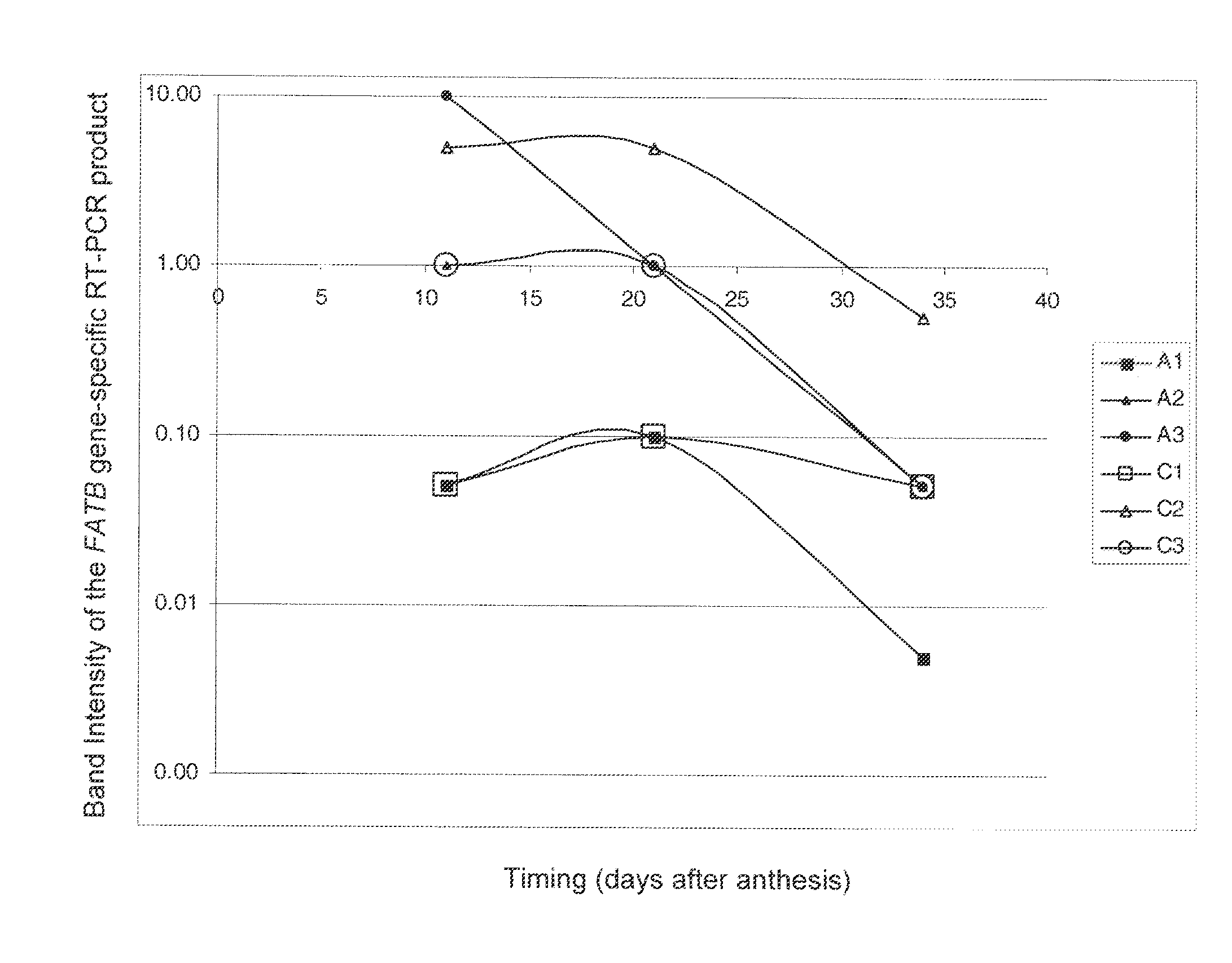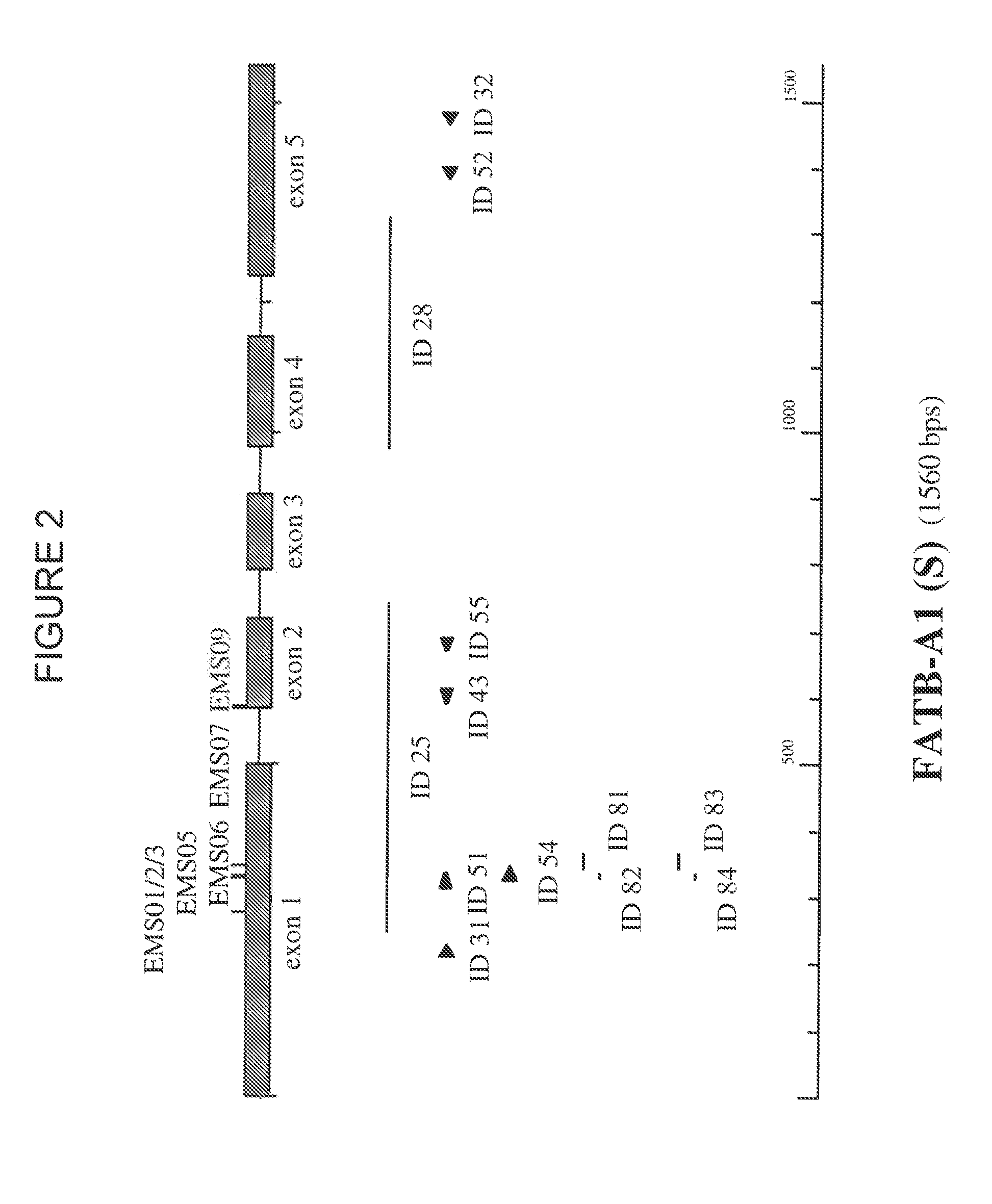Brassica plant comprising mutant fatty acyl-acp thioesterase alleles
a technology of acyl-acp thioesterase and plant, which is applied in the field of agricultural products, can solve the problems of not being able to reduce the level of saturated fatty acids by chemical modification, and not being able to achieve the desired effect of improving the healthiness of the oil for human consumption, and achieve the effect of reducing the level of functional fatb protein
- Summary
- Abstract
- Description
- Claims
- Application Information
AI Technical Summary
Benefits of technology
Problems solved by technology
Method used
Image
Examples
example 1
Determination of Number of FATB Genes in Brassica napus and Isolation of the DNA Sequences of the FATB Genes
[0472]To determine the number of FATB genes in Brassica napus and the sequences of the different FATB genes, Bacterial Artificial Chromosome (BAC) libraries of different Brassica napus varieties were screened as follows:
1.1. Isolation of BAC Clones Comprising a FATB Sequence
[0473]To identify Escherichia coli colonies containing a BAC clone comprising a FATB sequence of different Brassica napus varieties, BAC libraries of an elite Brassica napus spring oilseed rape line (hereinafter called “SOSR”) and of the Brassica napus winter oilseed rape variety Express (hereinafter called “WOSR Express”) (average clone size of more than 120 kb) arrayed as individual duplicated clones on high density nylon filters were screened by standard Southern hybridization procedures:[0474]DNA templates for the preparation of probes to detect the Brassica FATB genes were prepared by a polymerase chai...
example 2
Characterization of FATB Gene Sequences from Brassica napus
[0508]After sequencing, the coding regions of the FATB sequences were determined with FgeneSH (Softberry, Inc. Mount Kisco, N.Y., USA) and est2genome (Rice et al., 2000, Trends in Genetics 16 (6): 276-277; Mott, 1997, Comput. Applic. 13:477-478) as depicted in the sequence listing.
[0509]Alignment of the different FATB sequences with partial FATB sequences isolated from B. rapa (AA) and B. oleracea (CC) indicated that the FATB1, FATB2, and FATB3 sequences originated from the A genome and the FATB4, FATB5, and FATB6 sequences from the C genome.
[0510]Multi-way alignment (Align Plus program—Scientific & Educational Software, USA; using the following default parameters: mismatch penalty=2, open gap penalty=4, extend gap penalty=1; for nucleotides the default scoring matrix used is Standard linear and for proteins the default scoring matrix is BLOSUM62) of the different FATB coding regions with or without intron sequences and FAT...
example 3
Expression of Brassica FATB Genes
[0520]To analyze the expression of the different FATB genes in different tissues, semi-quantitative RT-PCR assays specific for each FATB gene were performed on total RNA isolated from various Brassica plant tissues:
Templates:
[0521]A series of increasing amounts of total RNA, i.e., 0.1 ng, 1 ng, 10 ng and 100 ng, isolated from leaves, roots, unopened flower buds and apices, cotyledons, pods 11 days after anthesis with and without seeds and seeds of those pods, seeds of pods 21 and 34 days after anthesis and callus of Brassica napus SOSR, with the RNeasy Plant Minikit (Qiagen) according to the manufacturer's instructions.[0522]A series of increasing amounts of genomic DNA, i.e., 0.1 ng, 1 ng, and 10 ng, isolated from leaf tissue of the Brassica napus SOSR according to the CTAB method (Doyle and Doyle, 1987, Phytochemistry Bulletin 19:11-15).
Primers and Length of the Fragment Amplified from the Target FATB Gene:[0523]to determine the expression of the F...
PUM
| Property | Measurement | Unit |
|---|---|---|
| Fraction | aaaaa | aaaaa |
Abstract
Description
Claims
Application Information
 Login to View More
Login to View More - R&D
- Intellectual Property
- Life Sciences
- Materials
- Tech Scout
- Unparalleled Data Quality
- Higher Quality Content
- 60% Fewer Hallucinations
Browse by: Latest US Patents, China's latest patents, Technical Efficacy Thesaurus, Application Domain, Technology Topic, Popular Technical Reports.
© 2025 PatSnap. All rights reserved.Legal|Privacy policy|Modern Slavery Act Transparency Statement|Sitemap|About US| Contact US: help@patsnap.com



